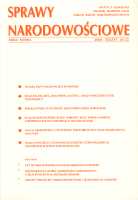Standaryzacja jęyka górnośląskiego i jej implikacje społeczno-polityczne (ze szczególnym uwzględnieniem Śląska Opolskiego)
Standardization of the Upper Silesian Language and ITS Social and Political IMPLICATIONS (Especially in Opole Silesia)
Author(s): Tomasz Dominik KamusellaSubject(s): Language and Literature Studies
Published by: Instytut Slawistyki Polskiej Akademii Nauk
Summary/Abstract: Upper Silesia is a Central European region today locted in Poland though its southernmost slither is also included in the Czech Republic. This division dates back to 1740-42 when Prussia wrested Lower and Upper Silesia away from Vienna. After World War I the German (Prussian) share of Upper Silesia was divided between Germany and Poland. During World War II National Socialist Germany seized almost entire historical Upper Silesia including Czechoslovakia’s section of this region. In 1945 this section was returned to Czechoslovakia, while the rest of Upper Silesia (along with almost all Lower Silesia) was granted to Poland. In the pre-modern times Latin, chancery German and chancery Bohemian (“Czech of the Prague court”) were used as written languages in Upper Silesia. After Prussia’s seizure of this region standard German won the day though in 1849-1873 standard Polish was introduced as a medium of education to elementary schools for Slavophone population. The conjunction between standard languages (construed as “national”) and Central European nationalisms strong, in the course of the 20th century standard Czech, German and Polish were forced on the inhabitants of Upper Silesia in an effort to make them into indistinguishable part of the Czech, German or Polish nation. In modern times the Upper Silesian population spoke West Germanic and North Slavic dialects as well as the Germanic-Slavic creole that emerged in the three last decades of the 19th century due to the intensive interaction of both these groups in the industrial basin. Shortly the Germanic-speakers acquired standard German, while frequent changes in the imposition of various standard languages on the Slavic-speakers entrenched them in their dialects and creole. After 1945 with the removal of Germans and the ban on German, this language and the Germanic dialects disappeared in Upper Silesia. Today the German minority speaks a Slavophone dialect and the creole to mark their ethnic difference vis-ŕ-vis the Polish nation, while these two language forms are used by those considering themselves of the Silesian nation/ethnic group for the very same purpose. Obviously, languages being the basis of Central European nationalism, standardization of Upper Silesia’s Slavophone dialect(s) and creole into a standardized Upper Silesia language may have wide-ranging effects: from divisive to integrating the ethnically variegated inhabitants of Upper Silesia.
Journal: Sprawy Narodowościowe
- Issue Year: 2004
- Issue No: 24-25
- Page Range: 113-132
- Page Count: 20
- Language: Polish

